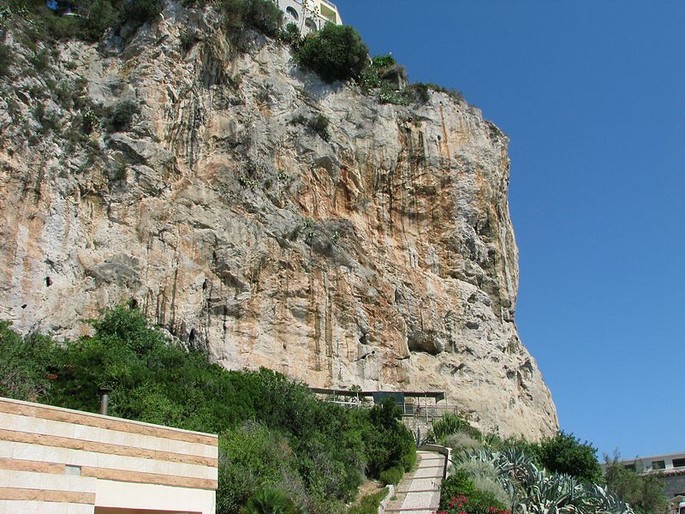The Boardwalk Balzi Rossi
Two beautiful stretches of coastal path, united by the Via Aurelia, let tread one of the few still intact portions of the Riviera di Ponente. The caves of Balzi Rossi with the interesting anthropological museum, around the tip of Garavano with the homonymous beautiful beach and a visit to the promontory of Capo Mortola, occupied by the gardens of Villa Hanbury but also crossed by a stretch of the ancient Via Julia Augusta and the remains of a nineteenth-century promenade, make this route very varied and rich in interesting features.
Via Julia Augusta
Leaving the cape of the Mortola, the Via Julia Augusta continued its route to Cemenelum through the cliffs of Balzi Rossi.
In the natural environment of the Balzi Rossi, it is hard to find (after the construction, in the twentieth century,of the railway line Ventimiglia-Nice and the damage caused by World War II) preserved traces of the ancient Roman road.
Today, downstream of the railway, you can see the only witness, a "cut" carved into the rock that allowed the passage, almost by the sea, of the Roman road.
Museum and caves
Balzi Rossi (Italian form from Ventimiglias dialect Bàussi Russians = "red rocks", in French also Baoussé-Roussé) is a name given to a beach (also known as "the beach of the eggs"), a museum and a cave complex in which there were discovered, in the second half of the nineteenth century, several finds of the Paleolithic era. The archaeological site is located near the hamlet of Ventimiglia Grimaldi, not far from the border crossing at Ponte San Ludovico between Italy and France.
The place owes its name to the typical color of the weathered rock, a high cliff about 100 m which consists of dolomitic limestone rich in iron ore. The site and the archaeological area are managed by the Superintendence of Cultural Heritage of Liguria.
The Prehistoric Museum of Balzi Rossi was founded in 1898 on the initiative of Sir Thomas Hanbury, who financed the construction of the said building and the arrangement of the Barma Grande, with the aim to show the public the exceptional Paleolithic remains, come to light as a result of quarry work, conducted on the rock wall where opens this cave.
The museum remained for many years as it was originally conceived, simple completion of the visit to the Barma Grande, in which were kept in place two Paleolithic burials and remains of an elephant.
Added later in an organized tour around the complex of the Casino, it remained a private institution until the fifties, when as a result of the serious damage caused by the war in the entire complex, it was sold to the state in 1955 and reopened as a national museum. Since then the display has been repeatedly updated and expanded.
The current set-up, completed in 1994 thanks to the expansion of the exhibition space obtained with the construction of the new museum building, is part of an integrated path to visit the museum and the archaeological area. From the new great room, which illustrates the history of research at Balzi Rossi, you proceed to visit the caves of Caviglione and Florestan and Shelter Mochi and the presentation of the most recent excavations, on two floors of the old museum building completely renovated. On the back of the new building is still visible the stratigraphy encountered during the work and excavated by the Superintendence for Archaeological Heritage of Liguria with the collaboration of M. Cremaschi (1990-1992).
Features
The complex is made up of fifteen cavities, of which the most important are (from west to east):
. The cave of Count Costantini
. Cave of the Children
. Cave Florestan, so named in honor of the Prince of Monaco which, in 1846 , financed the first excavations of the cave
. Shelter Mochi
. Caviglione cave
. The great Barma (barma means "cave" in the local dialect),
. The cave of the Prince, the largest (35 × 18 × 22 m)
Among the many artifacts found in them there are the remains of animals of different ages, human burials (around twenty), diverse objects (including statuettes - so-called Venus of Balzi Rossi - ornaments, stone tools) and even rock engraving depicting a horse. At least seven of the skeletons discovered are related to the presence of the Man of Cro-Magnon, whose type is referred to as local man of Grimaldi.
The main burials
The main burials, all of individuals of the Cro-Magnon type, stand out in a group recently dated final Epigravettian (like the children highlighted by Rivière and the female skeleton discovered in the upper layers of the children's cave), and a previous, Gravettian / Aurignacian. The lower horizon belongs to the Mousterian, and lack of human remains. The burials are as follows:
. The single burial, discovered in 1872 by Emile Rivière in the cave of Caviglione ("Man of Menton '): this is a tall individual (about 190 cm) wearing a headgear of shells and deer teeth. The body was covered with red ocher, buried on his left side, facing west, with the hands close to his face and legs folded.
. The triple burial, discovered in 1873 by the same Rivière in the Bausu by Ture cave, a teenager and two adult male with characters similar to those of the previous discovery.
. The double burial, discovered in 1874 by Emile Rivière still in the Children's cave, two children buried at a depth of 2.7 meters lying on their back with legs bent (hence the name of the cave) with the presence of various sea shells near the hip.
. The single burial discovered in 1884 by Louis Jullien, collector of antiquities who began digging in large Barma, finding a skeleton of an adult male sprinkled with ocher that was destroyed by the refusal of the owner of the cave, Giuseppe Abbo, to deliver the remains to the Museum of Menton; Jullien recovered instead a series of figurines called Paleolithic Venuses, characterized by highlighting genital and fertility attributes.
. The triple burial, consisting of three skeletons found in 1892 in the large Barma by Joseph Abbo; an adult male, a young man and a teenager are arranged in parallel in the same trench from east to west, and buried with a rich grave outfit including sea shells, flint blades and deer canines; the dating of the burial dates to about 20,000 years ago. The adult has a height around 190 cm and upper limb bones are very developed but strongly affected by arthritis, a sign of great strength combined with intense activity; an unusual feature for the modern man is a different structure of the axillary margin of the scapula, which shows a great muscle power.
. Two single graves, discovered in 1894, also by Giuseppe Abbo in the large Barma, one consisting of one adult male skeleton characterized by a strong dental wear and the other formed by the remains of an adult buried on an ancient fireplace;
. The double burial, discovered in 1901 by Canon Louis de Villeneuve in the cave of the Children, made up of an elderly woman and a teenager apparently not cromagnoide type, arranged in the same grave in a crouched position. It is to these individuals, in particular, that we owe the definition of "Negroid Grimaldi" (then "man of Grimaldi") because of the morphology apparently similar to modern human Negroid type. This at least is what was thought until the early seventies, when more detailed analyzes carried out by the dental anthropologist Pierre Legoux, showed that the facial prognathism was due in the case of the woman to a defect of chewing and for the teenager it was a counterfeiting made to include the discovery in cases of so-called "missing links" in the chain of evolution. In reality these two individuals belonged to the Cro-Magnon type like everyone else.
Man of Grimaldi
The elderly woman and a teenager in the double burial cave of the Children, although cromagnonoidi, differed for the particular characteristics of the individuals, at least in relation to other Homo sapiens in Europe. Anthropological characteristics of the type are:
. strong dolichocephaly;
, skull with an elliptical boundary,
. aristencefalo (1375 cc the woman, the boy 1570);
. cameprosopa face;
. strong undershot alveolar;
. cameconche orbits and subrectangular outline;
. broad nose (camerrinia) of Negroid morphology;
. short stature (159 cm the woman, the boy 156 cm);
. basin tall and narrow as in the Negroid.
S. Sergi along with Ugo Chiamparino proposed (1967) that Grimaldiani were of African origin, but the prevailing opinion is that the similarity with the Negroid doesn't involve genetic link. H. Vallois denies affinity. A new examination of the skull of the adolescent made between 1973 and 1974 by Olivier and Mantelin confirmed cromagnoide membership of the subject.




























